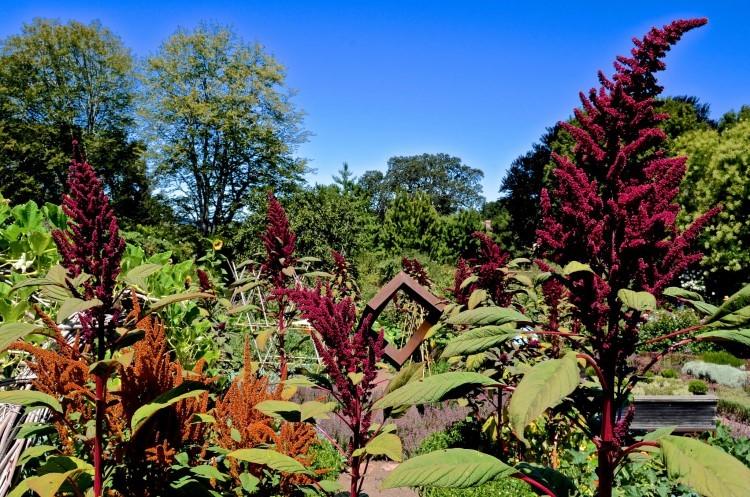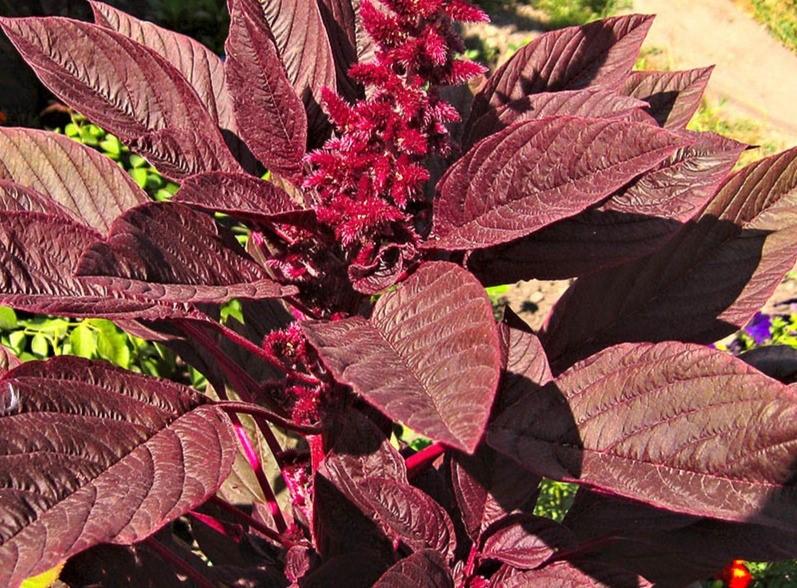Content
Amaranth is a herbaceous plant that is popular due to its excellent decorative properties. However, in addition to its appearance, it is very useful and can be used in cooking. Vegetable amaranth is an unpretentious crop that adapts well to different climatic conditions.
Description of vegetable amaranth
Vegetable amaranth belongs to the annual or perennial herbaceous species belonging to the Amaranthaceae family. He comes from America. Amaranth is not only a vegetable crop, it has excellent decorative qualities. Therefore, it is actively used to decorate the garden.
Amaranth is a tall plant with a tap root that goes deep into the ground. Depending on the variety, the length of the stem can reach up to 3 m and the diameter up to 10 cm. Vegetable amaranth has large leaves that have a slightly elongated shape. Color depends on the variety. Leaves may be yellow, red, orange or green.
Vegetable amaranth has a long flowering period. It blooms from July until the first frost. Flowers may have a red, crimson or brown tint. It depends on the specific variety. The inflorescences contain a large number of small flowers that are collected in panicles. Each variety has a different length and shape of these tails.

Inflorescences can be erect or pendulous
When ripe, a fruit is formed - a capsule with seeds. They are very small and have a smooth surface. Depending on the variety, they are colored in different shades: from yellow to black. Their germination lasts up to four years. The seeds are so small that there are about 2500 of them in 1 g.
Useful properties of vegetable amaranth
Vegetable amaranth is not only a beautiful, but also an incredibly useful plant. Leaves, roots and fruits are rich in vitamins B, C, E, PP, macroelements and polyunsaturated fatty acids. Amaranth contains a large amount of protein.
Eating it can strengthen the immune system and improve overall health. The plant has a short growing season and grows green mass very quickly. 70-120 days after planting, the greens can be picked for consumption.
Applications of vegetable amaranth
Vegetable amaranth has a wide range of applications. Fresh leaves can be added to summer salads. They are suitable for frying and stewing. Fresh or dried leaves can be brewed into tea.
Vegetable amaranth is popular in folk medicine. Various decoctions, tinctures of water and alcohol are made from it. Depending on the purpose, they are used internally or externally. I make compresses based on the plant.
Vegetable amaranth has contraindications.It is not recommended to eat it if you have individual intolerances or allergies. People with cholelithiasis, a tendency to hypotension, pancreatitis and cholecystitis should avoid using amaranth.
The best varieties of vegetable amaranth
Amaranth has a large number of varieties. Among vegetable varieties, certain names are most popular.
Valentina
A tall variety of vegetable amaranth, growing up to 1.7 m. It is abundantly covered with foliage, colored red-violet. It has not very dense, erect shoots of a crimson hue. Both leaves and seeds are suitable for consumption. They can be used raw or cooked in many dishes.

Parts of the plant do not lose their beneficial properties even after heat treatment
Sturdy
Amaranth is medium-sized, reaching a height of 1.4 m. The stem is densely covered with large foliage, painted in a rich green color. At the top of the head there are erect inflorescences with a brown tint. Flowers, foliage, and shoots are used for food consumption.

This variety is distinguished by early ripening, cut parts grow back quickly
In memory of Kvasov
A massive plant reaching a height of 1.1 m. On the shoots there are a large number of large leaves, painted in a rich green hue. Small inflorescences are collected in large panicles. They are painted in a rich red color, turning into a brown tint.

The green parts of the plant can be used as livestock feed
Opopeo
This variety is a medium-height plant with a powerful red stem. Along its entire length there are large, slightly elongated leaves. They are painted in a dark green shade.The erect red inflorescences are spike-shaped.

The leaves of the plant will add a delicious taste to vegetable salads.
Oscar Blanco
A massive plant reaching a height of 4 m. Small flowers are collected in short erect inflorescences. They have a dark red tint. The leaves and seeds of the plant are suitable for consumption. At the same time, there are more useful components in the latter.

This variety is considered one of the highest
White Leaf
A dwarf plant, the height of which varies within 20 cm. It has small leaf blades, painted in a light green shade. There are small inflorescences at the top. They have a soft creamy tint. The leaves are soft and very delicate in taste.

This variety is grown exclusively for greens
Kharkovsky-1
A massive plant with a powerful stem, reaching a height of 2-3 m. The leaves are quite large. Together with the stem, they are colored light green. Erect inflorescences are light cream in color. Seeds and leaves are used for food.

The variety has a high yield of up to 280 c/ha
Vegetable amaranth Ruby bouquet
The variety is medium in size, the stem height reaches 1.4 m. Large leaves have a rich red tint. The plant has erect inflorescences. The variety is suitable for consumption both raw and thermally processed. Young leaves, inflorescences and shoots are used for cooking.

From the moment of emergence of seedlings to technical maturity, about 70-80 days pass
Planting vegetable amaranth
There are two ways to plant vegetable amaranth: through growing seedlings or directly into open ground. The choice of a specific method depends on the weather conditions in a particular region.
Growing vegetable amaranth seedlings from seeds
You should start sowing seeds for seedlings at the end of March or early April. This process consists of the following steps:
- Fill the containers with moist soil. Place the seeds on the surface. Sprinkle with a thin layer of soil.
- Cover the container with film and place in a dark, warm place.
- After germination (about a week), move the plantings to light.
- After the second leaf has formed, plant the seedlings in separate containers.
The seedlings need to be transplanted into open ground in June. It is important that the earth has time to warm up sufficiently, and the likelihood of return frosts is left behind.
Planting seeds in open ground
Vegetable amaranth is an easy plant to grow. Feels great on different types of soil, including sandy and rocky. It is best to plant it in well-lit areas. They must be protected from gusts of wind.
It is worth planting seeds immediately in open ground after the soil has warmed up to at least +8 OC. There should be no chance of frost. The planting process consists of the following steps:
- Dig up the ground.
- Deepen the seeds into the soil 2 cm.
The distance between plantings depends on the purpose of cultivation. For greenery, you need to leave about 20 cm. When growing for flowers and seeds, plantings should be 60 cm apart.
The density of vegetable amaranth seeds when planting is 15 g per 100 m2.
Features of care
Vegetable amaranth is an undemanding plant to care for. However, in the first month after emergence, it needs increased attention. During this period, regular soil moistening, loosening, and weeding are needed. After germination, you can apply organic fertilizing.
In the second month after planting, amaranth will begin to actively gain green mass. During the day it will grow up to 5 cm. During this period, it needs to be watered on time and in sufficient quantities. To keep moisture in the soil longer, it is recommended to mulch the plantings.
During the season you can feed the plant several times. Complex mineral supplements are best suited for these purposes. It is recommended to apply fertilizer in the morning. The bush should be lightly watered first.
When growing amaranth to obtain seeds, you cannot wait until they are completely ripe on the plant. The inflorescences need to be cut off when they begin to turn red and dry out. They should be laid out on a flat surface to dry and ripen. After two weeks, the seeds are ready for collection. For this inflorescence you need to rub between your palms. As a result, the seeds will pop out on their own.
Diseases and pests
Vegetable amaranth is characterized by resistance to various diseases and pests. However, it can be attacked by weevils and aphids. To combat these pests, it is worth using fungicides.
If there is excessive moisture in the soil, amaranth can develop fungal infections. In this case, it is worth treating the plant with fungicide solutions.
As a preventive measure, it is necessary to follow the care recommendations and not to over-moisten the soil.
Conclusion
Vegetable amaranth is a universal plant that has a wide range of applications in both landscape design and cooking. Thanks to its low maintenance requirements, even a novice gardener can cope with its cultivation.














